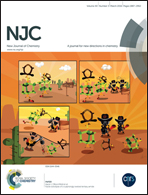Influence of the terminal donor on the performance of 4,8-dialkoxybenzo[1,2-b:4,5′]dithiophene based small molecules for efficient solution-processed organic solar cells†
Abstract
Two π-conjugated small molecules, BDT(TTBT)2 and BDT(PTBT)2, based on benzodithiophene (BDT) and benzothiadiazole (BT) substituted with different terminal groups such as hexyl-bithiophene and hexylphenyl-thiophene are investigated for use in solution-processed organic solar cells (OSCs). Investigations into the molecules reveal that variation of the terminal groups not only influences the optical and electronic properties, but also affects the crystallization and morphology of the small molecules. The BDT(TTBT)2 device showed a power conversion efficiency (PCE) of 1.73% as a consequence of deep HOMO (Voc = 0.81 V), improved charge delocalization, and strong light absorption (Jsc = 4.75 mA cm−2) when mild annealing was used as a result of improved texture in morphology, while the BDT(PTBT)2 device rather showed a moderate PCE of 1.22% with a Jsc of 2.88 mA cm−2, a Voc of 0.81 V, and a FF of 0.52.
![Graphical abstract: Influence of the terminal donor on the performance of 4,8-dialkoxybenzo[1,2-b:4,5′]dithiophene based small molecules for efficient solution-processed organic solar cells](/en/Image/Get?imageInfo.ImageType=GA&imageInfo.ImageIdentifier.ManuscriptID=C5NJ02529J&imageInfo.ImageIdentifier.Year=2016)

 Please wait while we load your content...
Please wait while we load your content...